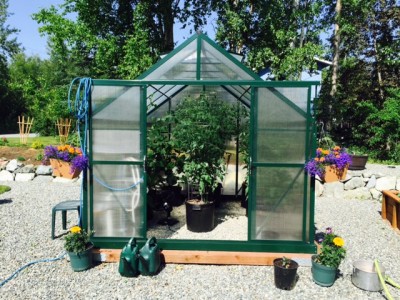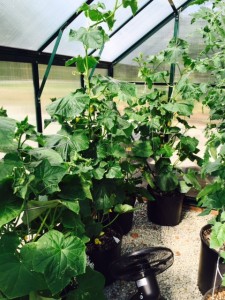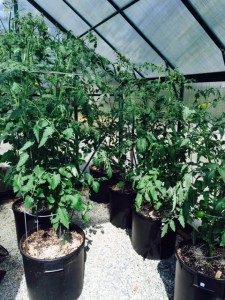A few years ago when I was getting close to retirement I was excited to begin my new life by spending time in the garden. For my birthday my sweet husband bought me a 6 x 8 greenhouse. I thought “awesome”. I’ve been gardening in Alaska (in the interior) for many years so this will be a piece of cake. When I started the greenhouse this spring, I soon found out how much I really didn’t know. So, to hopefully save you some anxiety I’ve put together a few things to consider for a successful crop of tomatoes and cucumbers in the greenhouse.
How big is the greenhouse? And, how many plants can you grow?
How many plants you can fit into your greenhouse is a big factor. But most importantly to think about – how big are my plants going to get? If you do everything right, tomato plants will get over 6 feet tall, so you can’t completely fill up the floor space because you won’t be able to get around to water and trellis as you need to.
If you want to grow cucumbers too they can be in a somewhat smaller pot, but as with the tomatoes, the stalk will be very large and heavy. You will need to trellis them as well as the tomatoes.
So, between tomatoes and cucumbers I have 11 plants. I actually think I have about two too many, but a friend of mine needed to get rid of a few so in my excitement I said yes. It’s difficult to work in there because of the size of the pots and plants, so make sure you give your self enough room to work, and to have a fan going for air circulation.
What type of equipment/dirt should I buy?
Here’s a list of minimal equipment you’ll need:
1. Very large tomato cages: One of my mistakes was buying too small of tomato cages. Buy the biggest ones you can get. My plants are over 6 feet tall already so I had to spend the day (in the heat) staking and trellising stalks. I almost cried when I discovered a stalk that had fallen over and broke. It had many tomatoes on it already so I was totally bummed. Having taller cages would have solved that problem.
2. At least 10-gallon containers: Tomato plants like their roots deep so buy at least a 10-gallon pot. In the heat lately I’ve had to water several times a day and without the larger pots I don’t think the plants would had one as well as they have.
3. Pro-mix dirt: You will need probably a minimum of 3-4 bales. Pro mix is expensive but worth it as I’ll explain later.
4. Vine clips, twine/string, plant Velcro 4 ft. and 6 ft. tall stakes, scissors: I’ve attached a picture of the vine clips that I use. I have used all three options depending on the situation.
5. Oscillating fan: Buy at least one depending on the size of your greenhouse and be sure the fan is oscillating to make sure you get good air circulation. Without adequate air circulation in a really hot summer you risk getting mildew on the leaves.
6. Water and electric near by: Water is critical especially in the type of summer we’ve had recently. 85 degree weather makes it difficult to regulate the heat even with vents and fans. Using pots for your plants has many positives, but a negative is you have to water more often. Having electricity is necessary if you’re using fans. Other wise you’ll also need an extension cord.
What kind of plants are good producers?
In my limited experience so far the cucumber plants I have are Jade, Diva and Tasty Jack. So far they have been great producers. The first harvest was on June 16th from the Jade variety which was thirty (30) days after transplanting into the greenhouse. All three varieties are loaded with fruit on them. The tomatoes I know are proven winners since I got them from a friend that have grown these varieties for several years. I have two plants that are heirloom Black Chrim and the others are all Black Cherry. I’ve eaten them in the past and are both very delicious. All plants are heavily laden with fruit as well.
Fertilizers:
I visited the Trinity Greenhouse in Kenai recently and they always have tomatoes that go from floor to ceiling. It’s truly amazing to see them so heavily laden with fruit. So, I asked the gardener what fertilizer they used and she told me they use a 20-20-20 on EVERYTHING. I have read many different articles regarding what fertilizer to use and it totally varies. So, I decided to add to my journal what the “locals” use in regards to fertilizer among other things. I figured I can read articles all day long written from someone in another state, but I’d rather go with more local information from someone that has had true success. Using 20-20-20 may not be a good option once fruit starts setting however. I would continue to research for the best option.
Other considerations:
Dirt and/or potting soil: for my flowers I usually use a Miracle Grow type potting soil and have been very successful. However, in the greenhouse I have used only Commercial Pro-Mix for numerous reasons. One, is tomato plants don’t like soggy soil. It’s a delicate balance between too little water and too much. The Pro-Mix has a mixture of Canadian sphagnum peat moss, per-lite, limestone a wetting agent and Mycorrhizae. After doing some research on Mycorrhizae and according to the Mycorrhizae company website, my understanding is these specialized fungi are effective in nutrient and water absorption thereby allowing the plant to absorb more of the soil resources. Additionally, one of the main benefits of the Pro-Mix is it’s less difficult to over water and the Mycorrhizae improves fertilizer uptake. More information is available at: https://www.promixfindgrowtopia.com/
Watering: here lately in the Mat-Su Valley we’ve had about a week of really hot weather – 85 degrees plus. So, I’ve had to water several times a day. All of the research tells me it’s better to water in the morning so the plants don’t get root rot, but with these very hot days I didn’t have a choice. I have watered around 5:00 however in the early evening and with our long daylight I still have another 3 or 4 hours of sunlight to help dissipate some of the water before the sun goes down. It appears to be a delicate balance between too little and too much. I also use a water meter which helps take some of the guessing out of the equation.
I’ve learned a lot already this summer about what works and what doesn’t. I’m sure as the years go on I’ll have a better understanding of how to be a more successful greenhouse gardener. But hey, I’m still having fun and the joy of checking in on things in the morning while drinking my first cup of coffee is what retirement is for. Happy Gardening!
For more information go to the UAF Cooperative Extension Service publications page and search for Greenhouse Gardening, Cucumber Production in Greenhouses etc. The website location is: https://www.uaf.edu/ces/pubs/catalog/search/index.xml




This is a great post. I helped a friend start a greenhouse one summer, just long enough to realize how different it was from having an outside garden, I can’t believe how big the tomatoes are. Really nice to hear from someone with Alaskan experience who started from scratch. Hope to have a greenhouse soon so I need all the information I can get. Right now I’ve got some tomatoes growing with a rain gutter sub-irrigation system in buckets on the porch. So far better luck than I’ve had in past years, the system is using less water overall, the plants look good and only dry out if I forget to fill the bucket. It sounds like a system like that might help with watering issues in the greenhouse. Lots of information on youtube – Larry Hall, self watering rain gutter grow system.
This is wonderful information about greenhouses. I too have a greenhouse and the learning curve has been steep in some areas. This is the first year I moved from planting the tomatoes in the 10 gallon pots to more of a raised bed. I’m still not sure I like it, but the plants do seem more vigorous this year. And thank you for the information on the amount of soil needed! It’s always a guess for me.
I have raised veggies and herbs in a greenhouse for several years (in the Mat-Su Valley of Alaska). The author raises excellent, practical points. I would like to reinforce two of her suggestions:
1) Two, inexpensive “desk” size fans clipped on the wall grid I use as a trellis eliminated the blossom rot and other problems I attributed to a still/humid environment in prior summers.
2) With electricity and nearby rain barrels, I was able to keep a 15 gallon barrel of compost tea aerating inside the green house (and near my exterior gardens). My first year impression of this organic fertilizer method was that the plants “weathered” dry to wet conditions more evenly than without. No “drama queen” dry periods, if you know what I mean, even in a summer that had some protracted hot spells (true in the exterior gardens, too). I know that one summer doesn’t cinch it, but I am certainly motivated to keep this up next year.
Other thoughts: We have a long raised bed along the north side in which I grow tomatoes, cucumbers, celery, peppers, and basil. During the winter (it is unheated but double insulated) I keep rabbits in there for several reasons (see alaskauu1.blogspot.com for more detail- article written around April, 2015) Their poop is just about the only one that a gardener can use fresh in a garden. They also dig and till in the raised bed, which is increasingly soft as early as February, and nibble the stalks I left from the prior fall (and it was a better nursery environment for them during deep cold).
Finally, I’d like to commend the application of companion planting. I grow basil plants in front of my tomatoes. They both do well,and the greenhouse smells terrific!
Thanks again for this useful article.
xx
Then, i thnk i am in a team ‘don’t know much about green house gardening’ 😀